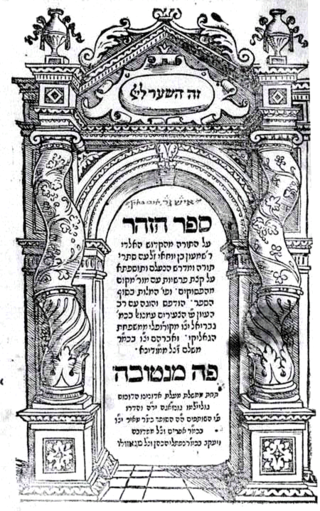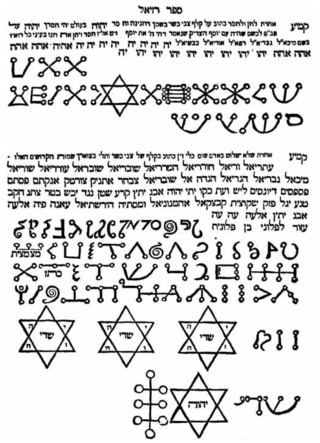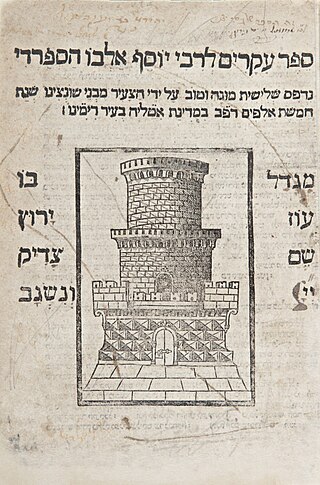Related Research Articles

The Zohar is a foundational work of Kabbalistic literature. It is a group of books including commentary on the mystical aspects of the Torah and scriptural interpretations as well as material on mysticism, mythical cosmogony, and mystical psychology. The Zohar contains discussions of the nature of God, the origin and structure of the universe, the nature of souls, redemption, the relationship of Ego to Darkness and "true self" to "The Light of God".

Abraham ben Meir Ibn Ezra was one of the most distinguished Jewish biblical commentators and philosophers of the Middle Ages. He was born in Tudela, Taifa of Zaragoza.

Sefer haYashar is a medieval Hebrew midrash, also known as the Toledot Adam and Divrei haYamim heArukh. The Hebrew title "Sefer haYashar" might be translated as the "Book of the Correct Record", but it is known in English translation mostly as The Book of Jasher following English tradition. Its author is unknown.

Saʿadia ben Yosef Gaon was a prominent rabbi, gaon, Jewish philosopher, and exegete who was active in the Abbasid Caliphate.

Abraham ben Samuel Abulafia was the founder of the school of "Prophetic Kabbalah". He was born in Zaragoza, Spain, in 1240, and is assumed to have died sometime after 1291 following a stay on the small and windswept island of Comino.
The Book of Jasher, which means the Book of the Upright or the Book of the Just Man, is a lost book mentioned in the Hebrew Bible, often interpreted as a lost non-canonical book. Numerous forgeries purporting to be rediscovered copies of this lost book have been written. A different interpretation identifies it as a reference to the Pentateuch, an interpretation which is notably favoured by the Jewish scholar Rashi in his commentary on the Hebrew Bible.
Bahir or Sefer HaBahir is an anonymous mystical work, attributed to a 1st-century rabbinic sage Nehunya ben HaKanah because it begins with the words, "R. Nehunya ben HaKanah said". It is also known as Midrash of Rabbi Nehunya ben HaKanahמִדְרָשׁ רַבִּי נְחוּנְיָא בֶּן הַקָּנָה.

Isaac Israeli ben Solomon, also known as Isaac Israeli the Elder and Isaac Judaeus, was one of the foremost Jewish physicians and philosophers living in the Arab world of his time. He is regarded as the father of medieval Jewish Neoplatonism. His works, all written in Arabic and subsequently translated into Hebrew, Latin and Spanish, entered the medical curriculum of the early thirteenth-century universities in Medieval Europe and remained popular throughout the Middle Ages.
Nissim ben Jacob, also known as Nissim Gaon, was a rabbi and Gaon best known today for his Talmudic commentary ha-Mafteach, by which title he is also known.
Aharon ben Joseph haLevi, known by his Hebrew acronym Ra'aH, was a medieval rabbi, Talmudic scholar and Halakhist.
The rabbinical translations of Matthew are rabbinical versions of the Gospel of Matthew that are written in Hebrew; Shem Tob's Hebrew Gospel of Matthew, the Du Tillet Matthew, and the Münster Matthew, and which were used in polemical debate with Catholics.

Josippon is a chronicle of Jewish history from Adam to the age of Titus. It is named after its supposed author, Flavius Josephus, though it was actually composed in the 10th century in Southern Italy. The Ethiopic version of Josippon is recognized as canonical by the Ethiopian Orthodox Tewahedo Church and the Eritrean Orthodox Tewahedo Church.

Sefer Raziel HaMalakh is a grimoire of Practical Kabbalah from the Middle Ages written primarily in Hebrew and Aramaic. Liber Razielis Archangeli, its 13th-century Latin translation produced under Alfonso X of Castile, survives.

Sefer HaIkkarim is a fifteenth-century work by rabbi Joseph Albo, a student of Hasdai Crescas. It is an eclectic, popular work, whose central task is the exposition of the principles of Judaism.
Sefer ha-Chinuch is a Jewish rabbinic text which systematically discusses the 613 commandments of the Torah. It was published anonymously in 13th-century Spain.
Yosef Qafiḥ, widely known as Rabbi Yosef Kapach, was a Yemenite-Israeli authority on Jewish religious law (halakha), a dayan of the Supreme Rabbinical Court in Israel, and one of the foremost leaders of the Yemenite Jewish community in Israel, where he was sought after by non-Yemenites as well. He is widely known for his editions and translations of the works of Maimonides, Saadia Gaon, and other early rabbinic authorities (Rishonim), particularly his restoration of the Mishneh Torah from old Yemenite manuscripts and his accompanying commentary culled from close to 300 additional commentators and with original insights. He was the grandson of Rabbi Yiḥyah Qafiḥ, a prominent Yemenite leader and founder of the Dor Deah movement in Yemen. Qafih was the recipient of many awards, as well as an Honorary Doctorate from Bar-Ilan University.
Moses ibn Tibbon was a Jewish physician, author and translator in Provence. The number of works written by Moses ibn Tibbon suggest that he reached a great age.
Jehiel ben Jekuthiel Anav, also referred to as Jehiel ben Jekuthiel ben Benjamin HaRofe, who lived in Rome during the thirteenth and fourteenth centuries, was a famous scholar, poet, paytan and copyist.
The Book of Nestor the Priest, originally titled Account of the Disputation of the Priest or its Hebrew textual avatar Sefer Nestor Ha-Komer is thought to be the earliest surviving anti-Christian Jewish polemic. The original version of the book was written in Judeo-Arabic and also a translation to Hebrew which confused an opening quote from Nestorius with the name of the author of the book, who is actually unknown. It cites extensively and critically from the New Testament and Church sources. The title komer (כומר) describes a Christian priest, rather than a kohen or Jewish priest. The text is written as the story of a Christian priest who converted to Judaism and wrote a critical account of the fundamental Christian doctrine regarding the nature of Jesus and the Trinity.
Jewish polemics and apologetics in the Middle Ages were texts written to protect and dissuade Jewish communities from conversion to Christianity, or more rarely to Islam. The terms polemics and apologetics may be distinguished but may also be considered somewhat subjective. A smaller number of proselytizing text also exists intended to convert Christians, or more rarely Muslims, to Judaism. However, the vast majority of Jewish polemical literature was written in response to Christian polemical writings and with a permanent reference to Christian arguments.
References
- ↑ Anna Sapir Abulafia, Religious Violence Between Christians and Jews: Medieval Roots, 2002, p. 94.